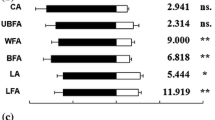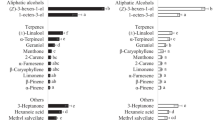Abstract
Anaphes iole Girault is a frequent parasitoid of Lygus spp. eggs in the United States, and has potential as a biological control agent against Lygus hesperus Knight in different crops. Feeding and oviposition by L. hesperus induce emission of plant volatiles, but studies to date do not address the role of plant volatiles in the host-searching behavior of A. iole. In this study, a four-arm olfactometer was used to test the responses of female parasitoids to odors emanating from cotton (Gossypium hirsutum L., Malvaceae) plants damaged by L. hesperus females, L. hesperus males, larvae of the nonhost Spodoptera exigua Hubner, or mechanically, or to odors from L. hesperus females alone. In addition, various plants damaged by L. hesperus females were evaluated in the olfactometer: cotton, alfalfa (Medicago sativa L., Fabaceae), common groundsel (Senecio vulgaris L., Asteraceae), annual ragweed (Ambrosia artemisifolia L., Asteraceae), and redroot pigweed (Amaranthus retroflexus L., Amaranthaceae). In all olfactometry bioassays, treatment odors were compared against three controls (humidified air). Results showed that A. iole females were consistently attracted to odors derived from different plant–L. hesperus complexes, while odors from plants subjected to nonhost (S. exigua) or mechanical damage and L. hesperus females alone were not attractive or only variably attractive. These findings suggest that while searching for hosts A. iole females use specific volatiles induced by L. hesperus feeding and oviposition to locate hosts inhabiting a wide variety of plants, including annual and perennial species from four plant families. It was suggested that future research should seek to identify the chemical elicitors involved in the release of plant volatiles attractive to A. iole females.
Similar content being viewed by others
References
Alborn, H. T., Lewis, W. J., and Tumlinson, J. H. (1997). An elicitor of plant volatiles from beet armyworm oral secretion. Science 276: 945–949.
Aldrich, J. R., Lusby, W. R., Kochansky, J. P., Hoffman, M. P., Wilson, L. T., and Zalom, F. G. (1988). Lygus bug pheromone vis-a-vis stink bugs. In Brown, J. M., and Richter, D.A. (eds.), Proceedings of the Beltwide Cotton Production Conferences, National Cotton Council of America, Memphis, Tennessee, pp. 213–216.
Anderson, R. A., and Schuster, M. F. (1983). Phenology of the tarnished plant bug on natural host plants in relation to populations in cotton. Southwest. Entomol. 8: 1131–1136.
Barlow, V. M., Godfrey, L. D., and Norris, R. F. (1999). Population dynamics of Lygus hesperus (Heteroptera: Miridae) on selected weeds in comparison with alfalfa. J. Econ. Entomol. 92: 846–852.
Beach, J. P., Williams, L., Hendrix, D. L., and Price, L. D. (2003). Different food sources affect the gustatory response of Anaphes iole, an egg parasitoid of Lygus spp. J. Chem. Ecol. 29: 1203–1221.
Beards, G. W., and Leigh, T. F. (1960). A laboratory rearing method for Lygus hesperus Knight. J. Econ. Entomol. 53: 327–328.
Clancy, D. W. (1968). Distribution and parasitization of some Lygus spp. in western United States and central Mexico. J. Econ. Entomol. 6: 443–445.
Clancy, D. W., and Pierce, H. D. (1966). Natural enemies of some Lygus bugs. J. Econ. Entomol. 59: 853–858.
Colazza, S., Fucarino, A., Peri, E., Salermo, G., Conti, E., and Bin, F. (2001). Cues mediating host location in Trissolcus basalts: The role of volatiles induced by host eggs--plant interaction. In Proceedings of the 18th Annual Meeting of the International Society of Chemical Ecology, Lake Tahoe, 81 pp.
Colazza, S., Fucarino, A., Peri, E., Salermo, G., Conti, E., and Bin, F. (2004). Insect oviposition induces volatile emission in herbaceous plants that attracts egg parasitoids. J. Exp. Biol. 207: 47–53.
Conti, E., Jones, W. A., Bin, F., and Vinson, S. B. (1996). Physical and chemical factors involved in host recognition behavior of Anaphes iole Girault, an egg parasitoid of Lygus hesperus Knight (Hymenoptera: Mymaridae; Heteroptera: Miridae). Biol. Control 7: 10–16.
Conti, E., Jones, W. A., Bin, F., and Vinson, S. B. (1997). Oviposition behavior ofAnaphes iole, an egg parasitoid of Lygus hesperus (Hymenoptera: Mymaridae; Heteroptera: Miridae). Ann. Entomol. Soc. Am. 90: 91–101.
de Moraes, C. M., Lewis, W. J., Paré, P. W., Alborn, H. T., and Tumlinson, J. H. (1998). Herbivore infested plants selectively attract parasitoids. Nature 393: 570–573.
Dicke, M. (1999). Are herbivore-induced plant volatiles reliable indicators of herbivore identity to foraging carnivorous arthropods? Entomol. Exp. Appl. 91: 131–142.
Fiaboe, M. K., Chabi-Olaye, A., Gounou, S., Smith, H., Borgemeister, C., and Schulthess, F. (2003). Sesamia calamistis calling behavior and its role in host finding of egg parasitoids Telenomus busseolae, Telenomus isis, and Lathromeris ovicida. J. Chem. Ecol. 29: 921–929.
Fritzsche-Hoballah, M. E., Tamo, C., and Turlings, T. C. J. (2002). Differential attractiveness of induced odors emitted by eight maize varieties for the parasitoid Cotesia marginiventris: Is quality or quantity important? J. Chem. Ecol. 28: 951–968.
Fye, R. E. (1980). Weed sources of Lygus bugs in the Yakima Valley and Columbia Basin in Washington. J. Econ. Entomol. 73: 469–473.
Graham, H. M., Jackson, C. G., and Debolt, W. J. (1986). Lygus spp. (Hemiptera: Miridae) and their parasites in agricultural areas of southern Arizona. Environ. Entomol. 15: 132–142.
Hilker, M., Kobs, C., Varama, M., and Schrank, K. (2002). Insect egg deposition induces Pinus sylvestris to attract egg parasitoids. J. Exp. Biol. 205: 455–461.
Ho, H., and Millar, J. G. (2002). Identification, electroantennogram screening, and field bioassays of volatile chemicals from Lygus hesperus Knight (Heteroptera: Miridae). Zool. Studies 41: 311–320.
Jackson, C. G., and Graham, H. M. (1983). Parasitism of four species of Lygus (Hemiptera: Miridae) by Anaphes ovijentatus (Hymenoptera: Mymaridae) and an evaluation of other possible hosts. Ann. Entomol. Soc. Am. 76: 772–775.
Kaiser, L., Pham-Delegue, M. H., Bakchine, E., and Masson, C. (1989). Olfactory responses of Trichogramma maidis Pint. et Voeg.: Effect of chemical cues and behavioral plasticity. J. Insect Behav. 2: 701–712.
Lewis, W. J., Jones, R. L., Nordlund, D. A., Gueldner, R. C., Teal, P. E. A., and Tumlinson, J. H. (1982). Kairomones and their use for management of entomophagous insects. XIII. Kairomonal activity for Trichogramma spp. of abdominal tips, excretion, and a synthetic sex pheromone blend of Heliothis zea (Boddie) moths. J. Chem. Ecol. 8: 1323–1331.
Loughrin, J. K., Manukin, A., Heath, R. R., Turlings, T. C. J., and Tumlinson, J. H. (1994). Diurnal cycle of emission of induced volatile terpenoids by herbivore-injured cotton plants. Proc. Natl. Acad. Sci. U.S.A. 91: 11836–11840.
McGregor, R., and Henderson, D. (1998). The influence of oviposition experience on response to host pheromone in Trichogramma sibericum (Hymenoptera: Trichogrammatidae). J. Insect Behav. 11: 621–632.
Meiners, T., and Hilker, M. (2000). Induction of plant synomones by oviposition of a phytophagous insect. J. Chem. Ecol. 26: 221–231.
Meiners, T., Westerhaus, C., and Hilker, M. (2000). Specificity of chemical cues used by a specialist egg parasitoid during host location. Entomol. Exp. Appl. 95: 151–159.
Noldus, L. P. J. J., Lewis, W. J., Tumlinson, J. H., and Van Lenteren, J. C. (1988). Olfactometer and wind tunnel experiments on the role of sex pheromones of noctuid moths in the foraging behavior of Trichogramma spp. In Trichogramma and Other Egg Parasites. lind International Symposium, Guangzhou (China), INRA, Paris, France, pp. 223–238.
Noldus, L. P. J. J., Van Lenteren, J. C., and Lewis, W. J. (1991). How Trichogramma parsitoids use moth sex pheromones as kairomones: Orientation behavior in a wind tunnel. Physiol. Entomol. 16: 313–327.
Paré, P. W., and Tumlinson, J. H. (1997a). Induced synthesis of plant volatiles. Nature 385: 30–31.
Paré, P. W., and Tumlinson, J. H. (1997b). De novo biosynthesis of volatiles induced by insect herbivory in cotton plants. Plant Physiol. 114: 1161–1167.
Rodriguez-Saona, C., Crafts-Brandner, S. J., Paré, P. W., and Henneberry, T. J. (2001). Exogenous methyl jasmonate induces volatile emissions in cotton plants. J. Chem. Ecol. 27: 679–695.
Rodriguez-Saona, C., Crafts-Brandner, S. J., Williams, L.W. III, and Paré, P. W. (2002). Lygus hesperus feeding and salivary gland extracts induce volatile emissions in plants. J. Chem. Ecol. 28: 1733–1747.
Sandlan, K. (1980). Host location by Coccygominus turionellae (Hymenoptera: Ichneumonidae). Entomol Exp. Appl. 27: 233–245.
Schuster, M. F. (1987). Biological control of plant bugs in cotton. In Hedlund, R. C., and Graham, H. M. (eds.), Economic Importance and Biological Control of Lygus and Adelphocoris in North America, USDA-ARS-64, pp. 13–19.
Scott, D. R. (1977). An annotated listing of host plants of Lygus hesperus Knight Bull. Entomol. Soc. Am. 23: 19–22.
Turlings, T. C. J., Loughrin, J. H., McCall, P. J., Röse, U. S. R., Lewis, W. J., and Tumlinson, J. H. (1995). How caterpillar-damaged plants protect themselves by attracting parasitic wasps. Proc. Natl. Acad. Sci. U.S.A. 92: 4169–4174.
Turlings, T. C. J., Tumlinson, J. H., Lewis, W. J., and Vet, L. E. M. (1989). Beneficial arthropod behavior mediated by airborne semiochemicals. VIII. Learning of host-related odors induced by a brief contact experience with host-by products in Cotesia marginiventris (Cresson), a generalist larval parasitoid. J. Insect Behav. 2: 217–226.
Turlings, T. C. J., Tumlinson, J. H., and Lewis, W. J. (1990a). Exploitation of herbivore induced plant odors by host-seeking parasitic wasps. Science 250: 1251–1253.
Turlings, T. C. J., Tumlinson, J. H., Eller, F. J., and Lewis, W. J. (1990b). How contact foraging experiences affect preferences for host-related odors in the larval parasitoid Cotesia marginiventris (Cresson) (Hymenoptera: Braconidae). J. Chem. Ecol. 16: 1577–1589.
Turlings, T. C. J., Tumlinson, J. H., Heath, R. R., Proveaux, A. T., and Doolittle, R. E. (1991). Isolation and identification of allelochemicals that attract the larval parasitoid, Cotesia marginiventris (Cresson), to the microhabitat of one of its hosts. J. Chem. Ecol. 17: 2235–2251.
Vet, L. E. M. (1983). Host -habitat location through olfactory cues by Leptopilina clavipes (Hartig) (Hym: Eucoilidae), aparasitoid of fungivorous Drosophila: The influence of conditioning. Neth. J. Zool. 33: 225–248.
Vet, L. E. M. (1985). Olfactory microhabitat location in some eucoilid and alysiine species (Hymenoptera), larval parasitoid of Diptera. Neth. J. Zool. 35: 720–730.
Vet, L. E. M., and Dicke, M. (1992). Ecology of infochemicals use by natural enemies in a tritrophic context. Annu. Rev. Entomol. 37: 141–172.
Vet, L. E. M., Van Lenteren, J. C., Heymans, M., and Meelis, E. (1983). An airflow olfactometer for measuring olfactory responses of hymenopterous parasitoids and other small insects. Physiol. Entomol. 8: 97–106.
Vinson, S. B., Barfield, C. S., and Henson, R. D. (1977). Ovipositional behavior of Bracon mellitor Say, aparasitoid of boll weevil Anthonomus grandis Boh. II. Associative learning. Physiol. Entomol. 2: 157–164.
Wardle, A. R., Borden, J. H., Pierce, H. D., Jr., and Gries, R. (2003). Volatile compounds released by disturbed and calm adults of the tarnished plant bug, Lygus lineolaris. J. Chem. Ecol. 29: 931–944.
Zar, J. H. (1999). Biostatistical Analysis, Prentice-Hall, Upper Saddle River, New Jersey.
Author information
Authors and Affiliations
Corresponding author
Rights and permissions
About this article
Cite this article
Manrique, V., Jones, W.A., Williams, L.H. et al. Olfactory Responses of Anaphes iole (Hymenoptera: Mymaridae) to Volatile Signals Derived from Host Habitats. J Insect Behav 18, 89–104 (2005). https://doi.org/10.1007/s10905-005-9349-5
Issue Date:
DOI: https://doi.org/10.1007/s10905-005-9349-5




